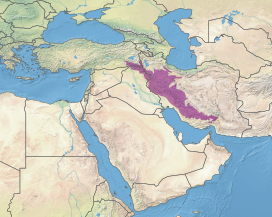Zagros Mountains forest steppe
| Zagros Mountains forest steppe | |
|---|---|
 Landscape near Shadegan | |
 Map of the ecoregion | |
| Ecology | |
| Realm | Palearctic |
| Biome | temperate broadleaf and mixed forests |
| Borders | List
|
| Geography | |
| Area | 397,555 km2 (153,497 sq mi) |
| Countries | |
| Conservation | |
| Conservation status | Critical/endangered[1] |
| Protected | 20,339 km2 (5%)[2] |
The Zagros Mountains forest steppe is a
Geography
The Zagros Mountains are a belt of folded mountains formed by the collision of the
Climate
The ecoregion's climate is semi-arid and temperate. Annual precipitation ranges from 400 m to 800 mm, and falls mostly in winter and spring. Summers are hot and dry, and winters are cold, with the coldest winter temperatures dropping below −25 °C (-13 °F). Temperatures are generally warmer and the climate drier at the southern end of the range.
Flora

The predominant plant community in the mountains is forest or open woodland of deciduous broadleaf trees, with an understory of steppe shrubs and grasses. Oaks, particularly
At the southern end of the range, the trees are sparser and more open, and the steppe vegetation is more prominent. Steppe extends up to 1400 meters elevation, and open woodlands of Quercus brantii, hawthorn (Crataegus), almond (Prunus amygdalus), nettle tree (Celtis spp.) and pear (Pyrus syriaca and Pyrus glabra) continue up to 2,400 meters.[1]
Although degraded from overgrazing and deforestation, the Zagros is home to a rich and complex flora. Remnants of the originally widespread oak-dominated woodland can still be found, as can park-like pistachio-almond steppelands. The wild ancestors of many important food plants, including wheat, barley, lentil, almond, walnut, pistachio, apricot, plum, pomegranate, and grape, grow throughout the mountains.[4]
Fauna
The Zagros are home to many threatened and endangered animals, including the
In the late 19th century, the Asiatic lion (Panthera leo persica) inhabited the southwestern part of the mountains.[6] It is now extinct in this region.[7]
The Luristan newt (Neurergus kaiseri) is a vulnerable species endemic to the central Zagros mountains of Iran.
Protected areas
A 2017 assessment found that 20,339 km2, or 5%, of the ecoregion is in protected areas.[2] Protected areas include:[8]
- Arjan and Parishan Protected Area(IUCN category V, 597.8 km2)
- Bamou National Park (IUCN category II, 486.8 km2)
- Bakhtegan Wildlife Refuge(IUCN category IV, 2004 km2)
- Kolahghazi Wildlife Refuge (IUCN category IV, 41.2 km2)
- Dez Wildlife Refuge (IUCN category IV, 53 km2)
- Bijar Protected Area (IUCN category V, 316.1 km2)
- Bahramgor Protected Area (IUCN category V, 4080 km2)
- Angoran Protected Area (IUCN category V, 923.2 km2)
- Dez Protected Area (IUCN category V, 175.3 km2)
- Karkheh Protected Area(IUCN category V, 140 km2)
External links
- "Zagros Mountains forest steppe". Terrestrial Ecoregions. World Wildlife Fund.
References
- ^ a b c d "Zagros Mountains forest steppe". Terrestrial Ecoregions. World Wildlife Fund.
- ^ PMID 28608869.) Supplemental material 2 table S1b.
{{cite journal}}: CS1 maint: date and year (link - ^ M. Heydari; H. Poorbabaei; T. Rostami; M. Begim Faghir; A. Salehi; R. Ostad Hashmei (2013). "Plant species in Oak (Quercus brantii Lindl.) understory and their relationship with physical and chemical properties of soil in different altitude classes in the Arghvan valley protected area, Iran" (PDF). Caspian Journal of Environmental Sciences, 2013, Vol. 11 No. 1, pp. 97~110. Archived from the original (PDF) on 3 April 2015. Retrieved 10 April 2014.
- ISBN 0-8173-5349-6. Retrieved 5 May 2012.
- ^ "Haji Omran Mountain (IQ018)" (PDF). natrueiraq.org. Retrieved 22 June 2016.
- ^ Kitchener, A. C.; Breitenmoser-Würsten, C.; Eizirik, E.; Gentry, A.; Werdelin, L.; Wilting A.; Yamaguchi, N.; Abramov, A. V.; Christiansen, P.; Driscoll, C.; Duckworth, J. W.; Johnson, W.; Luo, S.-J.; Meijaard, E.; O'Donoghue, P.; Sanderson, J.; Seymour, K.; Bruford, M.; Groves, C.; Hoffmann, M.; Nowell, K.; Timmons, Z.; Tobe, S. (2017). "A revised taxonomy of the Felidae: The final report of the Cat Classification Task Force of the IUCN Cat Specialist Group" (PDF). Cat News. Special Issue 11.
- ISBN 90-04-08876-8.
- ^ "Zagros Mountains forest steppe". DOPA Explorer. Accessed 8 December 2020. [1]
